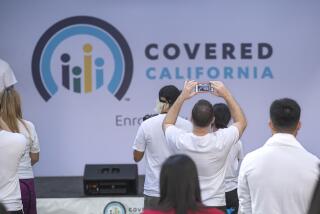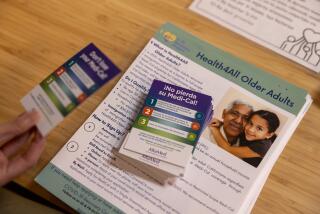Healthcare coverage counselor stymied by website problems

Passport and tax records in hand, Nela Barboza fiddled nervously with a plastic folding fan as she approached Jessie Orozco’s desk. “Buenas tardes,” she said cordially. “I’m here to sign up for Obamacare.”
Orozco, a benefits counselor at St. John’s Well Child & Family Center in South Los Angeles, was thrilled. Around her neck, she wore a badge certifying that she was a state-trained enrollment counselor for California’s new medical insurance marketplace — touted as one of the better-functioning parts of the Obama administration’s healthcare overhaul.
With a picture of the president tacked to the wall behind her, Orozco noted that Barboza could be the first person she would walk through the process of signing up. “I’m going to celebrate when I get this lady approved!”
The sense of anticipation quickly dissipated. Orozco encountered problems with the state website created for counselors like her. She couldn’t find forms in Spanish, the language Barboza best understands. She had trouble estimating the costs Barboza would pay and confirming details of what would be covered.
Barboza became agitated, complaining at one point that she and her husband would be better off if he didn’t work because they would get government-paid medical care.
The state has struggled to put enough trained troops like Orozco on the front lines of the healthcare overhaul. Officials say they are catching up and are poised to help millions of Californians reap the benefits of Obamacare.
From the vantage point of Orozco’s desk, that hope was tempered by the reality of continuing obstacles. Computer glitches persisted, misinformation and rumors were in the air, and consumers procrastinated, worried about the unknowns of choosing a health plan and what it could mean for their care and their pocketbooks.
::
Covered California, the state marketplace, got relatively high marks last week when officials released initial enrollment figures under the Affordable Care Act.
More than 30,000 Californians had selected insurance plans during the first month of sign-ups, and about the same number chose plans during the first 12 days of November. An additional 72,000 used the exchange to find out they were probably eligible for expanded coverage under Medi-Cal, the state’s healthcare program for the poor.
Nationwide, 106,185 people enrolled in Affordable Care Act plans during October, far short of Obama administration goals.
The mix of patients at community clinics like St. John’s underscores the complexity of matching people and medical insurance. Many are undocumented and can’t participate in the state insurance exchange or receive full Medi-Cal coverage. Another large group is already enrolled in Medi-Cal or Healthy Way L.A., a low-income county program that will be folded into Medi-Cal on Jan. 1. Orozco and her colleagues at the clinic had been successfully signing up people for those programs for months.
Another smaller group is made up of lower-income workers who will be required to purchase insurance. Those patients now can apply through the state’s online marketplace or via enrollment counselors like Orozco. If they qualify, they can obtain government assistance to help pay the premiums.
After a rocky first few days, state officials said last week that 70% of patients using the public enrollment website, at https://www.coveredca.com, reported the application was easy to complete. Some were able to enroll in just 15 minutes, the exchange reported.
On her first day as an enrollment advisor, Orozco logged onto a separate website used by counselors — and the trouble began.
“You can look, but you can’t use the website to do the income calculation,” Orozco told Barboza and her sister Rosa Aguirre, who was along to apply for her own insurance.
The women waited patiently as Orozco struggled to estimate costs and get descriptions of coverage options. The site froze up repeatedly. Clicking on Spanish-language links led to English pages. A drop-down menu asked how the women learned about Covered California. But the answer options weren’t working; they were all blank.
Barboza gradually grew distressed as Orozco sought to explain the insurance plans. She’d hoped to sign up for Medi-Cal. Her sister, whose only income is rent she collects from Barboza and other relatives who live in her South Gate home, was likely to qualify for that program.
But Barboza’s husband earns close to $24,000 a year — too much for the couple to qualify for Medi-Cal.
Without access to a fully functioning website, Orozco tried to describe how the insurance plans and pricing would work.
Barboza became alarmed when she saw the full, unsubsidized cost of the plan she was considering: several hundred dollars a month.
Orozco said the couple would receive government assistance with the premium. (According to the state’s public website, they would probably pay between $28 and $104 per month).
Barboza and Aguirre didn’t appear to understand. Why did they have to pay a high premium? Barboza wondered. Why was Covered California looking at their gross income and not what remained after taxes and expenses?
Illnesses prevented her from holding a job, Barboza said, and her husband’s employer would not provide full-time hours or affordable medical benefits.
In the end, Orozco printed out a paper application, in English, and wrote down a phone number for Barboza to call for a Spanish-language copy. She didn’t want to discuss the couple’s options further until they had a chance to review them in the language they understood.
The sisters gathered their things and left. Orozco was certain they would be back.
But as days wore on and messages went unreturned, her confidence flagged. “I really don’t know if they’re coming back at all,” she wrote in an email six days after the women’s initial visit. “Patients forget, or simply procrastinate.”
Reached by a reporter that day, Aguirre said she had found a social worker who was helping her with her Medi-Cal enrollment. Barboza and her husband might go back to Orozco, she said.
“My sister has a problem,” she added. “They have to get insurance. They think: We eat, or we pay for insurance.”
::
Orozco’s problems with the website for enrollment counselors continued.
Tiring of waiting online or on hold on the phone — and concerned that patients would not complete the process on their own — she took to printing out applications in English and helping patients, many Spanish speaking, to fill them out.
Friday afternoon, she poked at her keyboard, trying to access the website’s chat function. A pop-up box appeared: This site has been disabled for the time being.
“It’s depressing, it’s frustrating and it’s disrespectful,” she said.
Orozco printed out forms and helped three patients submit them for coverage through the state marketplace.
She still hadn’t heard from Barboza. That celebration was on hold.
Twitter: @LATerynbrown
More to Read
Start your day right
Sign up for Essential California for news, features and recommendations from the L.A. Times and beyond in your inbox six days a week.
You may occasionally receive promotional content from the Los Angeles Times.







